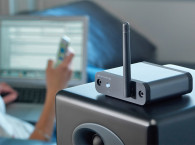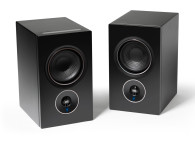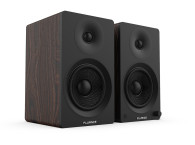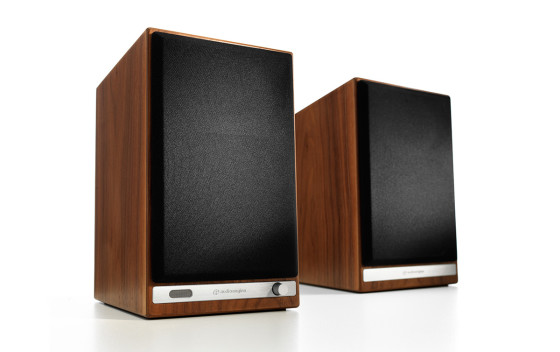
They actually look like classic bookshelf-style speakers, but that’s until we have a look at the back panel of one of the HD6 speakers - the one with the volume control on the front - and notice the large heath-sink, sided by a wide variety of connectors, including optical… and an antenna. That’s when we understand that the HD6 is a fully featured 150W (50W RMS, 75W peak per channel), DAC and Bluetooth 4.0 audio solution. The second speaker in the HD6 system is a passive unit.
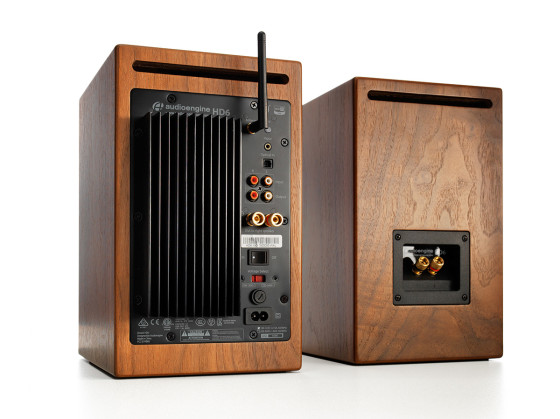
The HD6 Bluetooth receiver and optical input both utilize the AKM AK4396A DAC. The optical input configures the AK4396A as a bit-perfect 24-bit DAC, which will process sample rates up to 192kHz natively and for Bluetooth the AK4396A is used as an upsampling DAC and will pad all bit depths to 24-bits, achieving a higher signal-to-noise ratio and lower noise floor. “Due to the high signal-to-noise specs of the AK4396A, the fact that digital signal is upsampled, as well as the added benefit of onboard triple redundancy power source conversion and filtering, the HD6 Bluetooth implementation presents impressive low noise and low distortion characteristics with a noticeable improvement over other Bluetooth devices,” says Audioengine.
“Super-easy to use and designed for the way people listen to music today,” says the Texas-based company, describing its new HD6 active speakers which allowing streaming TIDAL, Spotify, Pandora, YouTube, iTunes or any music service or media player wirelessly from a smartphone, tablet or computer. “Also easily connect your TV system, Sonos Connect, network music player, or any other device that has optical out. And vinyl lovers can also add their favorite turntable to one of the preamp inputs. No matter how you connect and listen, HD6 has you covered,” they add.
 “As we celebrate our tenth year this month,” says Brady Bargenquast, co-founder of Audioengine, “HD6 represents a decade’s worth of work. We’ve added some stellar features from our best-selling products, carefully blended in our signature sound, and also took a calculated risk with the retro cabinet design - all of which we’re hoping will make HD6 the go-to music system for many years to come.”
“As we celebrate our tenth year this month,” says Brady Bargenquast, co-founder of Audioengine, “HD6 represents a decade’s worth of work. We’ve added some stellar features from our best-selling products, carefully blended in our signature sound, and also took a calculated risk with the retro cabinet design - all of which we’re hoping will make HD6 the go-to music system for many years to come.”“We started with our tried-and-true amplifier design and added an optical input from the D1 DAC. We also included our Advanced Bluetooth and 24-bit upsampling circuitry from the B1 Bluetooth Receiver, making the HD6 our most versatile speaker system yet,” adds Dave Evans, co-founder and chief technologist.
The HD6 is Audioengine’s latest statement on high-quality and highly-affordable audio. It uses built-in class A/B monoblock power amplifiers, 1” (25mm) silk dome tweeters with neodymium magnets, 5.5” (140mm) Kevlar woofers with advanced voice coils and diecast aluminum frames, and built-in linear power supplies with toroidal power transformer.
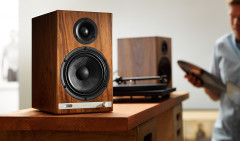 The furniture-grade wood veneers - available in Satin Black, Walnut or Cherry wood - and detachable magnetic grills give the HD6 a look and feel of old-school design elegance that blends with any decor. The woofers have aluminum frames allowing the lower-end to really perform, and the tweeters have smoother, more extended highs and improved imaging.
The furniture-grade wood veneers - available in Satin Black, Walnut or Cherry wood - and detachable magnetic grills give the HD6 a look and feel of old-school design elegance that blends with any decor. The woofers have aluminum frames allowing the lower-end to really perform, and the tweeters have smoother, more extended highs and improved imaging.The Audioengine HD6 Premium Powered Speaker System has a retail price of $749 per pair and is available now.
www.audioengineusa.com



